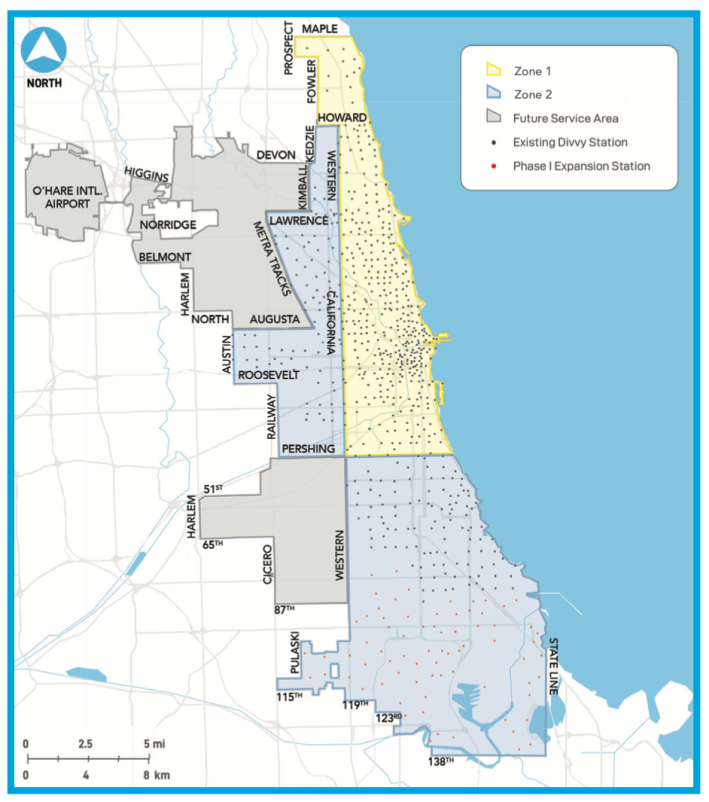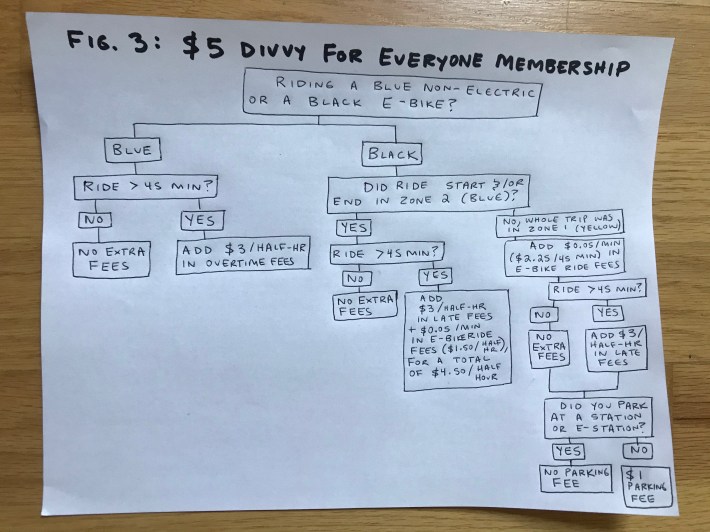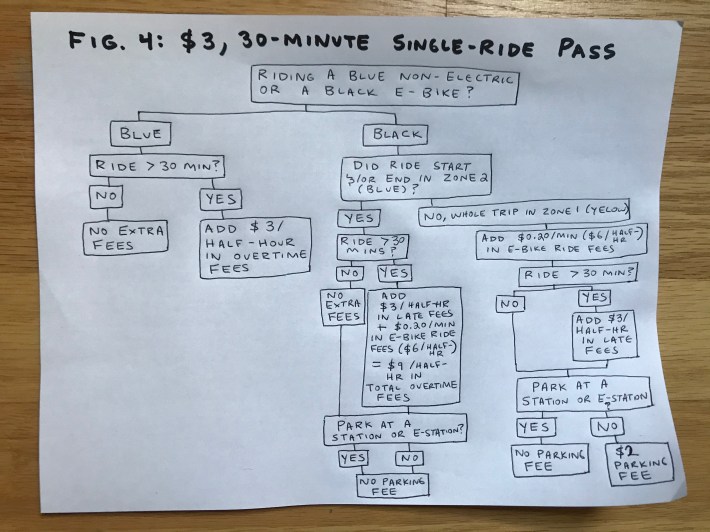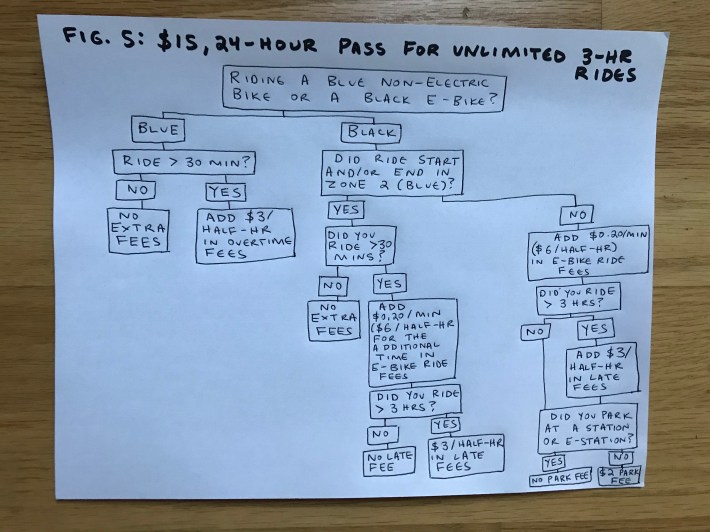It's great that Divvy is rolling out electrical-assist bikes tomorrow, and it's terrific that the new pricing scheme has an eye on equity. As a rule, (although it's not 100-percent the case), there will be no special surcharges to use the black e-bikes in lower-income communities of color on the South and West sides with a lower density of residents, destinations, and bike-share stations, generally located in Zone 2 (blue) on the map below.
Meanwhile, in Zone 1, the yellow area north of Pershing Road and east of Western Avenue, which is generally (but not always) whiter and wealthier, with a higher density of people, destinations, and stations, there will be extra fees to ride the black cycles and to park them at at bike racks or poles, rather than traditional docking stations, or the new "e-station" bike rack installations, intended for e-bikes only.

The downside of this policy is that it makes the already-complex Divvy pricing system ridiculously complicated. Here are all the variables under the new system:
- Are you using a regular annual membership, a reduced-price Divvy for Everyone membership, a single-ride pass, or a Day Pass?
- Are you checking out a blue non-electric bike or a black e-bike?
- Will your ride begin and/or end in Zone 2, (blue) or just Zone 1 (yellow)?
- Are you racking up any overtime fees (complicated by the fact that different kinds of memberships and passes allow you to hold onto bikes for 30, 45, or 180 minutes before you get late charges)?
- Are you parking at a station or e-station, or using an e-bike's built-in cable lock to park at a rack or pole?
We posted an overview of the pricing system yesterday, but I was still having trouble complete wrapping my head around it. But that's understandable, because the Chicago Department of Transportation and Divvy itself have made errors explaining how the pricing and surcharges work.
So to get to the bottom of all this, I spent many hours today pouring over CDOT press releases and the Divvy website to figure out what the heck is going on. I've boiled down the pricing system into a five-part flowchart that hopefully will make it easier to understand what you'll pay when you use the bike-share system from now on. But to give you an idea of how ludicrously complicated this task was, here's the first draft of my flowchart, which occupied four pieces of paper taped together. (Yes, I'm something of a Luddite.)

But don't study that image too carefully, because I think I figured out how to break down the information into relatively bite-sized pieces. OK, start your journey of discovery by checking out this first chart below to determine (if you haven't already) whether you'll be using an annual membership, a low-cost Divvy for Everyone membership, a single-ride pass, or a 24-hour Day Pass, and then follow the instructions on where to go next.

All right, if you intend to purchase, or already posses, a regular annual membership, check out Figure 2 below for a breakdown of how much it will cost to use the system, depending on what kind of bike you'll be using, where you'll be riding, how long you'll keep it, and where you'll be parking.

If you want to ride long-term and qualify residence- and income-wise for a Divvy for Everyone membership, see Figure 3 below to see how the new pricing system will affect how much you pay.

If you only want to dip your toe in the Divvy system waters, see Figure 4 below to understand how the new pricing system impacts $3 sing-ride pass users.

And to see how the pricing works for the $15, 24-hour Day Pass option, which gives you unlimited three-hour rides, check out Figure 5 below. In case things weren't convoluted enough, when you use a Day Pass, the first 30 minutes of an e-bike ride that starts and/or ends in the blue zone don't involve a surcharge, and then you pay 20 cents a minute to use the e-bike after that, but if you hold onto the bike for more than three hours, you pay an additional $3 late fee for each extra half-hour. Confused about how that works? Don't feel bad -- CDOT was too. But hopefully the flowchart below will help make things clearer.

All right then, got all that? To be honest, after processing all of this data, my brain is completely fried. (I did my best to make this accurate, but apologies in advance for any typos in the flowcharts -- if you notice any, please email jgreenfield[at]streetsblog.org an I'll fix them.) But here are a few takeaways for e-bike use strategy that spring to mind.
- It's always a good idea to avoid overtime on a Divvy, but it's especially important if you're riding a black bike in the blue zone, because you'll not only pay late fees, but you'll also start accruing the e-cycle surcharge when you wouldn't otherwise.
- Accept that using the e-bikes exclusively within the yellow zone is relatively expensive, and you should instead use a blue bike if you want to save money. However, it appears that you can avoid the e-bike riding surcharge by checking out a bike in the yellow zone, crossing the border and parking in the blue zone, then checking out another bike and riding it to your destination in the yellow zone.
- Likewise, if you do an e-bike trip that starts and ends in the yellow district, locking the bike to a rack or pole right by your destination is a luxury that will cost a dollar or two more, so use a station or e-station instead if you don't want to spend that money. Personally, if I felt like paying for parking, I'd drive a car instead of riding a bike.
- For goodness sake, if you're using a Day Pass and staying within the yellow zone, don't hold onto a black bike for a whole three-hour time slot unless you feel like burning through a lot of money -- you'll pay $30 in e-bike riding surcharges.
I'm sure you clever Streetsblog readers will figure out more strategy tips after you check the charts. Let us know in the comments section what other rules of thumb you come up with.
And if any tech geniuses among you feel like trying your hand at creating an app to calculate the cost of a Divvy trip under the new system (note that Google Maps will soon be providing directions between Divvy stations), that would be swell.
Follow John Greenfield on Twitter at @greenfieldjohn.





